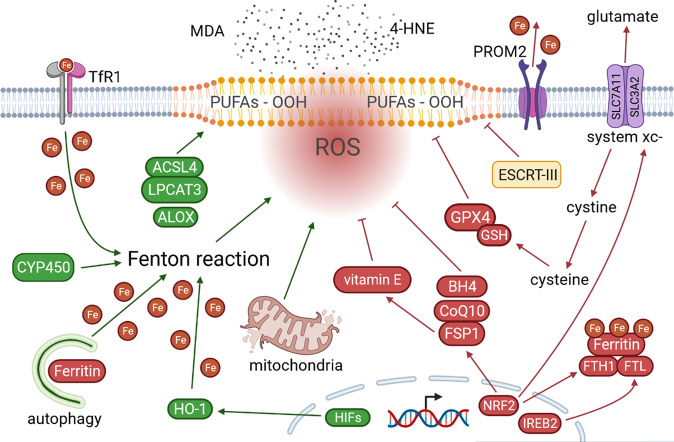Fig. 1. Ferroptosis mechanisms.
Ferroptosis can be initiated by non-enzymatic and enzymatic processes. The non-enzymatic process includes Fenton reaction, where iron and hydrogen peroxide react and form free radicals. Various enzymes and proteins drive ferroptosis via increasing iron availability and enhancing free radical formation (CYP450, HO-1, HIFs), and performing important roles in biosynthesis and oxidation of PUFAs (ACSL4, LPCAT3, ALOX). In contrast, ferroptosis is suppressed by several enzymes and cofactors with antioxidant functions (GPX4, GSH, FSP1, CoQ10, BH4) and system xc- cystine/glutamate antiporter (SLC7A11 and SLC3A2) that import cystine which is necessary for the biosynthesis of antioxidant enzymes. Consequences of ferroptosis are various harmful breakdown products (e.g., MDA and 4-HNE), modified and oxidized proteins (e.g., reparatory ESCRT-III), damaged mitochondria and eventual disruption of membrane integrity. MDA, malondialdehyde; 4-HNE, 4-hydroxy-2-nonenal; TfR1, transferrin receptor 1; PUFAs-OOH, polyunsaturated fatty acid peroxides; ROS, reactive oxygen species; PROM2, prominin 2; system xc-, cystine/glutamate antiporter; SLC7A11, solute carrier family 7 member 11; SLC3A2, solute carrier family 3 member 2; ESCRT-III, endosomal sorting complexes required for transport-III; Fe, ferrum (iron); ACSL4, acyl-CoA synthetase long-chain family member 4; LPCAT3, lysophosphatidylcholine acyltransferase 3; ALOX, lipoxygenase; CYP450, cytochrome P450; GPX4, glutathione peroxidase 4; GSH, glutathione; BH4, tetrahydrobiopterin; CoQ10, coenzyme Q10; FSP1, ferroptosis suppressor protein 1; FTH1, ferritin heavy chain 1; FTL, ferritin light chain; NRF2, nuclear factor E2-related factor 2; IREB2, iron-responsive element binding protein 2; HIFs, hypoxia-inducible factors; HO-1, heme oxygenase-1. Created with BioRender.

